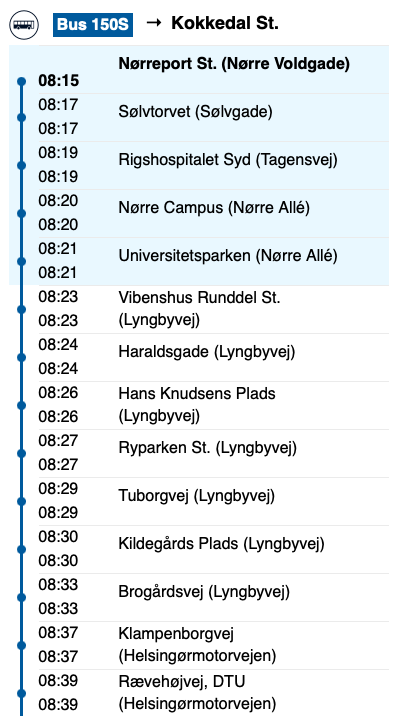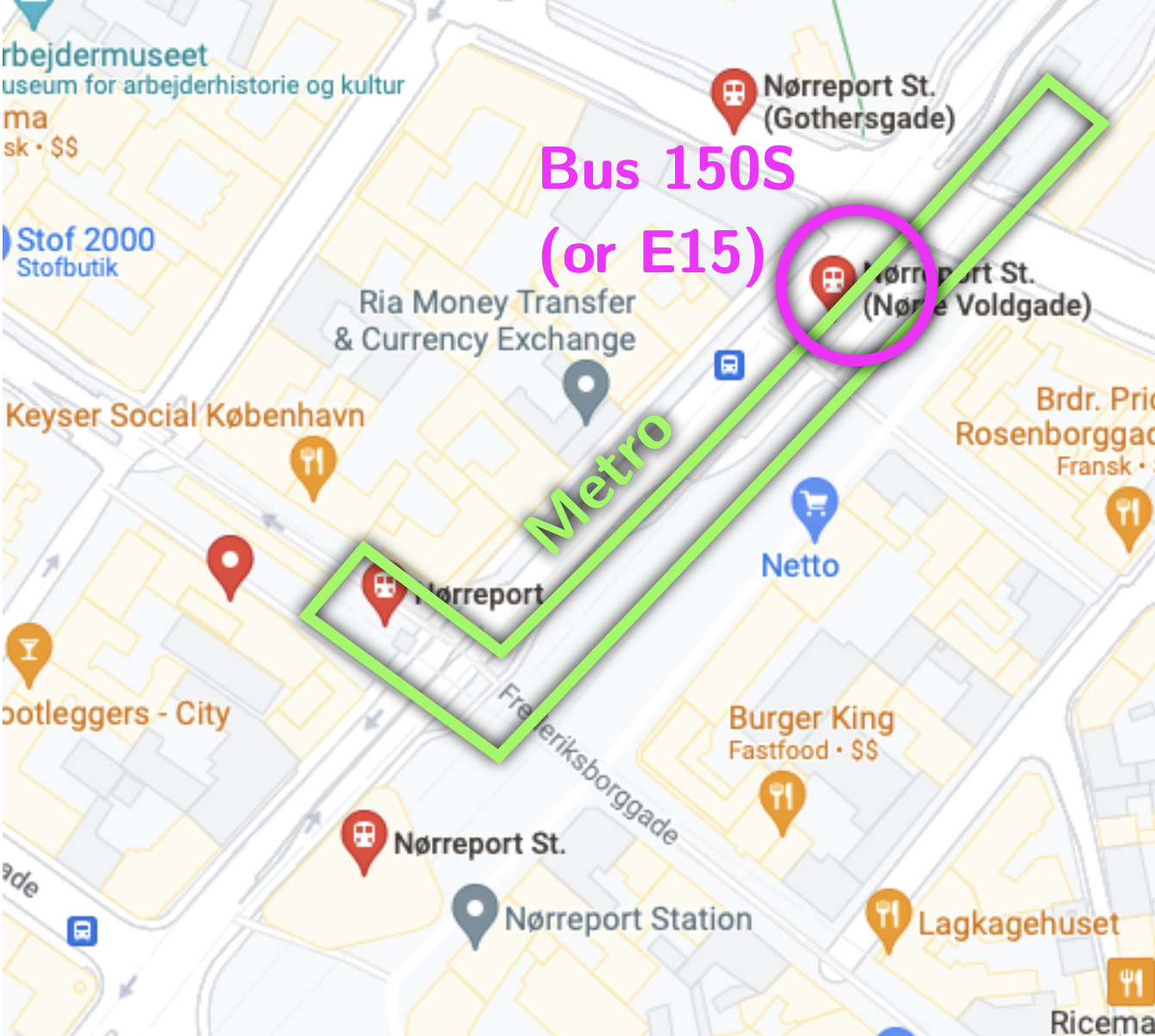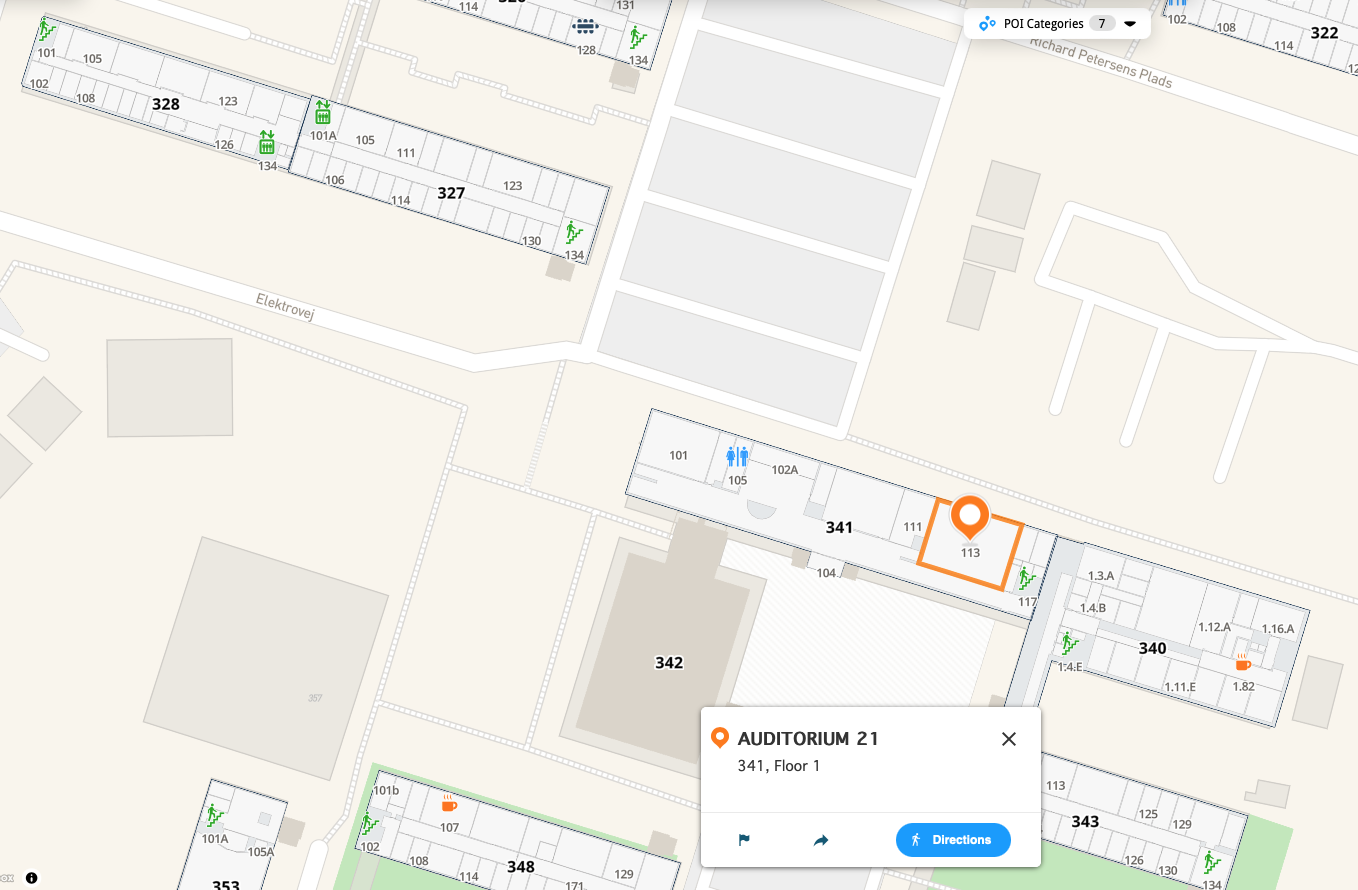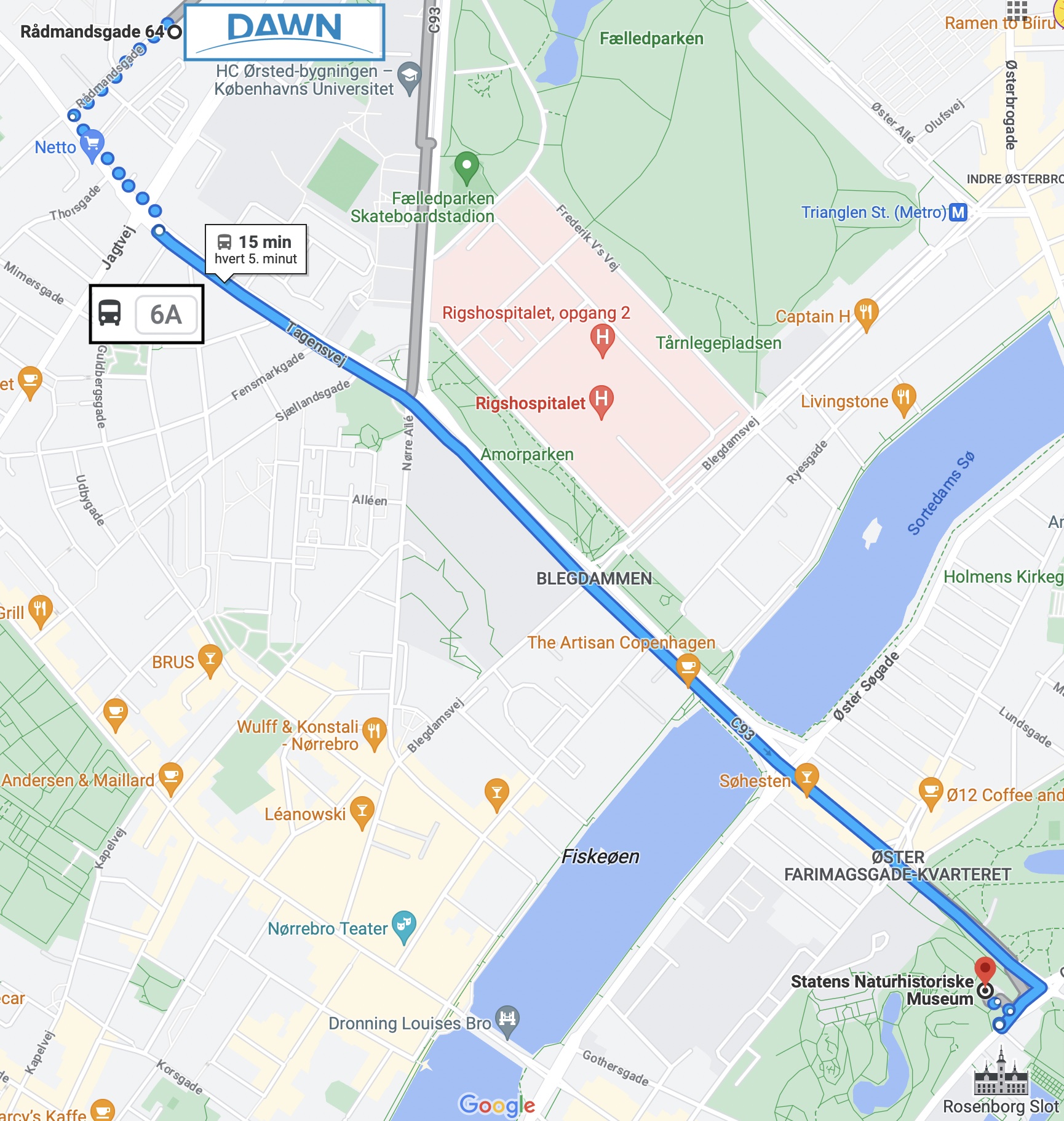About the Summit
We are pleased to announce the annual summit at the Cosmic Dawn Center.
Objective
Each year, new faces appear at DAWN, and you forget what your old colleagues are spending their time on. The purpose of the DAWN Summit is to get to know each other, scientifically and socially, get an overview of the science of DAWN, and hopefully spawn new collaborations.
Time and venue
The meeting will take place on 26–28 June.
Monday 26 June, 9:00–14:30, at DTU
The first day will be at DTU, which is north of Copenhagen.
- Cycling from the Niels Bohr Building (NBB) is 11 km.
- Alternatively, Bus 150S (and E15) leaves every 5 minutes from Nørreport in the center of Copenhagen, past the NBB, and to DTU in 25 minutes. Get off at "Rævehøjvej, DTU" and walk the 15 minutes to Building 341 (the address of which is Ørsteds Plads 342), then find Auditorium 21 on the first floor.
See also here how to get from the airport to Nørreport.
Tuesday & Wednesday 27–28 june, 8:30–16:30, at the Geological Museum
The second and third day will be at the Geologisk Museum, 2½ km from DAWN/NBB. Walk (30 minutes), or take bus 6A (15 minutes):
Talks
Present your nice results or null-result, or explain where you're stuck and could use some input from colleagues.
Unless recordings or call-ins are specifically requested, the meeting will be in-person only. This is to avoid the significant overhead when dealing with bad connections, computer setups, etc. between the talks.
Contributed talks
should be roughly 15+3 minutes, so that a new speaker may start every 20 minutes.
Review talks
will be ~25 minutes, plus time for questions and discussions; 30 minutes in total including overhead. They will focus on advances in the field particularly within the last year.
LOC & SOC
Helena and Guarn know about the practical stuff. Peter knows about the scientific stuff. Call me if you panic.
List of participants
Listed in order of registration time.
| 1. Pascal Oesch (U. of Geneva) |
| 2. Helena Baungaard (NBI) |
| 3. Francesco Valentino (ESO) |
| 4. Kasper Elm Heintz (NBI) |
| 5. Shuowen Jin (DTU) |
| 6. Guarn Nissen (NBI) |
| 7. Minju Lee (DTU) |
| 8. Steven Gillman (DTU) |
| 9. Clara Giménez Arteaga (NBI) |
| 10. Aswin P Vijayan (DTU) |
| 11. Marko Shuntov (NBI) |
| 12. Georgios Magdis (DTU) |
| 13. Kate Gould (NBI) |
| 14. Victoria Strait (NBI) |
| 15. Michael I. Andersen (NBI) |
| 16. Vadim Rusakov (NBI) |
| 17. Guozhen Ma (NBI) |
| 18. Charles Steinhardt (NBI) |
| 19. Malte Brinch (DTU) |
| 20. Jasleen Matharu (NBI) |
| 21. John Silverman (Kavli IPMU; U. of Tokyo) |
| 22. Albert Sneppen (NBI) |
| 23. Thomas Greve (DTU) |
| 24. Bitten Gullberg (DTU) |
| 25. Mason Huberty (University of Minnesota) |
| 26. Umran Koca (Caltech) |
| 27. Bo Milvang-Jensen (NBI) |
| 28. Francesca Rizzo (NBI) |
| 29. Bright Liu (Harvard University) |
| 30. Lijie Liu (DTU) |
| 31. Peter Laursen (NBI) |
| 32. Sune Toft (NBI) |
| 33. Michael Gutierrez (Caltech) |
| 34. David Sanders (Univ. of Hawaii) |
| 35. Johan Fynbo (NBI) |
| 36. Natalie Allen (NBI) |
| 37. Vasily Kokorev (Kapteyn Astr. Inst.) |
| 38. Thorbjørn Clausen (NBI) |
| 39. Iris Jermann (DTU) |
| 40. Arden Shao (Caltech) |
| 41. Tom Reynolds (U. of Turku) |
| 42. Anne Hutter (NBI) |
| 43. Birgitta Nordström (NBI) |
| 44. Lise Christensen (NBI) |
| 45. Jonas Stahlschmidt (NBI) |
| 46. Dazhi Zhou (DTU) |
| 47. Kristian Finlator (NMSU) |
| 48. Kate Whitaker (UMass Amherst) |
| 49. Desika Narayanan (university of flori-duh) |
| 50. Claudia Lagos (UWA, ICRAR, ASTRO3D) |
| 51. Conor McPartland (NBI) |
| 52. Nikolaj Sillassen (DTU) |
| 53. David Blanquez (DTU) |
| 54. Gabriel Brammer (NBI) |
Program
Times are approximate. Click talks to view abstracts.
You can download a .pdf version of the program by clicking this button:
Monday 26 June
Monday's program will end around 14:30.
Venue: DTU, Aud. 21, building 341
Ørsteds Pl. 342
2800 Kongens Lyngby
(84 m from DTU Space)
09:00
Light breakfast
09:30
Welcome
Sune Toft, Thomas Greve, & Georgios Magdis
09:50
First stars and galaxies / reionization
Review by Aswin Vijayan
TBA
10:40
Coffee break
11:15
TBA
Quasars are extremely luminous sources, and useful as beacons to probe the environment of the high-redshift environments in their host galaxies, their ability to ionise their surroundings, as well as examining metal content in gas clouds in the early Universe. In this talk, I will present exquisite, high S/N JWST NIRSpec spectra of quasars at z>6.5. Since the same stars that produce metals also contribute to reionization, we can investigate the correlation between either high- and low-ionization metal absorbers and transmission peaks that appear in the GP troughs. Finally, we investigate the metal abundance patterns in the presumably low-metallicity high-redshift environments in the search for the earliest chemical enrichment signatures.
The Cosmic Dawn Survey is a deep multiwavelength survey of the Euclid deep and auxiliary fields. The survey covers ~50 sq. deg. of the sky with ground-based data from CFHT MegaCam, Subaru HSC, and Rubin as well as space-based data from Spitzer IRAC and Euclid. This talk presents the survey fields, photometric depths, and science goals of the survey.
12:15
Lunch
Sandwiches will be provided.
13:30
Special topic: DAWN 2
Moderators: Sune Toft, Thomas Greve, & Georgios Magdis
14:00
SURF@DAWN student's presentations
TBA
TBA
TBA
TBA
TBA
TBA
Tuesday 27 June
Tuesday's program will end around 16:30.
Venue: Geological Museum
Øster Voldgade 5–7
The Auditorium
08:30
Light breakfast
09:00
Galaxy evolution
Review by Marko Shuntov
I will present the results of a 60-hour ALMA campaign targeting a lensed sub-L* galaxy at z=6.07. This object is a normal main-sequence star-forming galaxy belonging to the numerous population that might have contributed to the Reionization of the Universe. I'll show results about dust production, gas masses, and star formation efficiencies at mass and luminosity regimes unattainable for field galaxies. The wealth of information makes this object the perfect template to plan and propel future multi-facility studies of normal objects at z>6.
High redshift quiescent galaxies beyond z>1 are fascinating that make us wonder what turns them inactive in the early universe. We investigate this question by using one of the deepest ALMA observations made in Band 4 (a total of 24-hr). We discovered a dust-rich, massive (Mstar ~ 1e11 Msun) quiescent galaxy candidate at z~2 that exhibits a high dust-to-stellar mass ratio of ~0.3%. The galaxy possesses one of the highest dust content measured in quiescent galaxies at high redshift. The talk will discuss the nature of the source, and comparison with the latest measurements in the local and distant galaxies by performing spectral energy distribution fitting. Finally, it will conclude with challenges given the current dust measurements.
10:50
Recent observations of high-redshift galaxies with the James Webb Space Telescope revealed that star formation commonly occurs in small spherical or irregularly-shaped structures. This is in contrast to the complex morphology of the typical galaxies with bulges, discs and spiral arms towards the cosmic noon and later observed with the Hubble Space telescope (HST). By bridging the gap between these stages with the existing observations, it should be possible to build a more complete picture of morphological evolution. This work approaches the following questions: when and why do galaxies start to build their stellar disks? Is galaxy evolution a three stage process: bulge formation - disk formation - quiescent ellipticals?
No.
11:30
Special topic: DJ Archive
Moderators: Gabe Brammer, Kate Gould, Marko Shuntov, Kasper Heintz, Conor McPartland
14:00
TBA.
TBA.
I will present a first spatially resolved overview of a lensed HST-dark galaxy, spectroscopically confirmed with ALMA at z=2.58. Thanks to the synergy between JWST and ALMA we were able to reveal a largely uniform Av~4 area, which spatially matches to the ALMA 1 mm continuum emission. Most importantly, accounting for the limits of current JWST surveys, unlensed analogs of our HST-dark object at z>4 will only be detectable in F356W and F444W, becoming totally JWST-dark at z~6. Implying that discovering dusty star-forming galaxies in the EoR is a challenging task for JWST. Finally, I will introduce my ongoing work in the UNCOVER survey to study the lensed ALMA-detected HST-dark galaxies in the A2744 field.
15:00
Coffee break
15:45
We investigated the spatial distribution of submillimeter galaxies (SMGs) in the vicinity of the high-redshift radio galaxy (HzRG) 4C23.56 as part of the RAGERS (The RAdio Galaxy Environment Reference Survey) project. We found a perpendicular alignment between the orientation of the radio jet and the SMGs, suggesting a sign of large-scale filaments, or an impact from the central radio-AGN. Additionally, the bright SMGs tend to avoid the protocluster core and favor the outskirts, possibly due to AGN feedback or fastened galaxy evolution in the core. These findings provide interesting insights into the interplay between HzRGs, SMGs, and their environments.
In this talk I am going to present the COSMOS-Web catalog of photometry from space and ground based instruments using a model-fitting approach. I will present the methodology and the resulting distributions of physical properties from SED-fitting.
Wednesday 28 June
Wednesday's program will end around 16:30.
At 17:45 we will re-meet at Nyhavn for a canal tour, after which we will have dinner. See below for further details.
Venue: Geological Museum
Øster Voldgade 5–7
The Auditorium
08:30
Light breakfast
The next break, at 9:50, will have no coffee unfortunately, so make sure to fill that cup to the brim ☕️
09:00
Putting in all together (theory)
Review by Kristian Finlator
Whether the few bright or numerous faint galaxies reionised the intergalactic medium during the first billion years remains an outstanding question and depends on how the fraction of ionising photons escaping from galaxies scales, on average, with the galaxy mass. Various theoretical works have explored the benefits of synergising 21cm signal and Lyman-alpha emitter (LAE) surveys. I will discuss how the analytical expression for the 21cm-LAE cross-correlation function that we have derived now can help us to understand the signatures of the ionisation topology in the 21cm-LAE cross-correlations, and thus the galaxy population driving reionisation and how the ionising escape fraction depends on galaxy mass.
09:50
Break sans café
Hope you didn't forget coffee in the morning…
10:35
Galaxies exhibit a diverse variety of structures over many orders in magnitude in spatial scales. Given the high-resolution of recent observations, especially with JWST, these spatial scales and the interplay between them can be explored at smaller scales and with unprecedented detail in the near-infrared and mid-infrared. In this talk, I will present how the Fourier transform and the power spectral domain provides a useful mathematical framework for examining galaxy structure. This method is complementary to the standard methods of visual inspection of galaxies with the power spectral domain especially emphasises higher frequency structures and the interplay between spatial scales.
i mean you saw my title right?
11:15
Lunch
Lunch on your own.
We recommend walking through the Botanical Garden to "Torvehallerne" where all sorts of (street) food can be found.
13:30
Quenching
Review by Kate Gould
Over the last two years we have worked intensively to improve the SHARK semi-analytic model by including more sophisticated models of AGN feedback (radio and QSO mode), environmental treatment of satellite galaxies, dynamical friction timescales, among several other physical processes. We are culminating this development and plan for a series of three papers to be submitted this year presenting the new SHARK model, analysing the AGN population and a thorough investigation of the parameter space. One aspect that this new SHARK version does much better than the previous one is the quenching of massive galaxies. During this talk I will show some of the key results we are getting in connection to massive quenched galaxies at high redshift.
14:20
Coffee break
15:20
Updates from the UNCOVER survey -- I can send a more complete abstract if needed, but just submitting this now. We have some first results in size-mass relations of low-mass quiescent galaxies led at UMass, but a wider range of galaxy evolution studies too (for context of the appropriate possible sessions below).
TBA.
JWST has unveiled many ultra red galaxies already in its first year of launch. In this talk I will discuss what these are, why JWST is so important for studying them, and how they are important for uncovering the mysteries of galaxy evolution.
17:45
Canal tour
From 17:45 to 18:45, we will take a guided canal tour, departing from Nyhavn 71.
Please be there at 17:30!
From the Geological Museum, it's a 20 minute walk.
19:00
Dinner
The canal tour will end near Restaurant Kanalen where we will have dinner.
The address is Wilders Plads 2 (in case you miss the boat).
Alternatives are provided with those with special requests.
- Starter
- Cava & snacks
- Menu
- White asparagus with hand-peeled prawns, chives and airy hollandaise
- Young rooster breast from Gråsten with new potatoes, scallions, beech mushrooms, and sauce blanquette
- Strawberry trifle with vanilla cream
- Kanalen's home-baked focaccia with virgin olive oil
- Filtered water with and without gas
- Wines
- Sauvignon Blanc / Viognier l'Expression Terre et Mer IGP Cevennes France
- Pinot Noir P & A Nicolas Potel Bourgogne & Stephane Aviron Beaujolais France
- Muscat Beaume de Venice Rhône France
- Coffee






